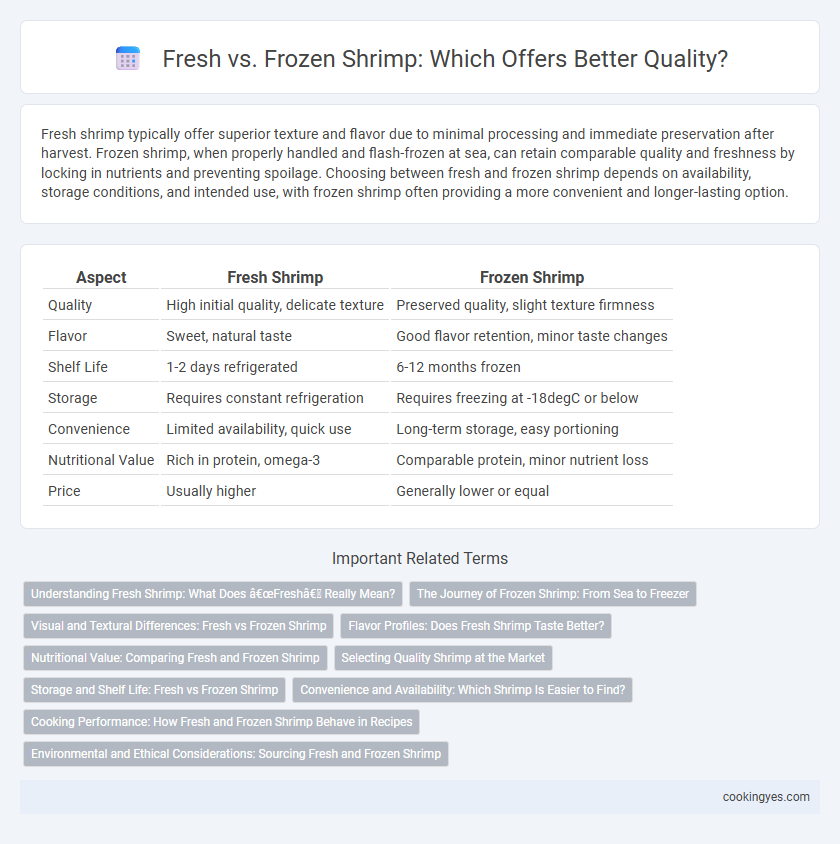Fresh shrimp typically offer superior texture and flavor due to minimal processing and immediate preservation after harvest. Frozen shrimp, when properly handled and flash-frozen at sea, can retain comparable quality and freshness by locking in nutrients and preventing spoilage. Choosing between fresh and frozen shrimp depends on availability, storage conditions, and intended use, with frozen shrimp often providing a more convenient and longer-lasting option.
Table of Comparison
| Aspect | Fresh Shrimp | Frozen Shrimp |
|---|---|---|
| Quality | High initial quality, delicate texture | Preserved quality, slight texture firmness |
| Flavor | Sweet, natural taste | Good flavor retention, minor taste changes |
| Shelf Life | 1-2 days refrigerated | 6-12 months frozen |
| Storage | Requires constant refrigeration | Requires freezing at -18degC or below |
| Convenience | Limited availability, quick use | Long-term storage, easy portioning |
| Nutritional Value | Rich in protein, omega-3 | Comparable protein, minor nutrient loss |
| Price | Usually higher | Generally lower or equal |
Understanding Fresh Shrimp: What Does “Fresh” Really Mean?
Fresh shrimp is often perceived as superior in quality, but "fresh" can be misleading since most shrimp labeled as fresh have been previously frozen on boats to preserve safety and texture. True fresh shrimp means it has never been frozen, maintaining a delicate texture and sweeter flavor, but is highly perishable and requires immediate consumption or refrigeration. Understanding the supply chain and labeling practices helps consumers make informed choices between fresh and frozen shrimp based on taste preference and shelf life.
The Journey of Frozen Shrimp: From Sea to Freezer
Frozen shrimp maintain peak freshness through rapid freezing methods immediately after being caught, preserving texture and flavor superior to shrimp that spoil during long transport. The journey from sea to freezer involves flash freezing on fishing vessels, locking in nutrients and preventing bacterial growth that compromises quality. This process guarantees consumers shrimp that taste as fresh as those caught that day, often surpassing the quality of fresh shrimp subjected to delays and temperature fluctuations.
Visual and Textural Differences: Fresh vs Frozen Shrimp
Fresh shrimp exhibit a translucent, glossy appearance with a firm, springy texture that indicates optimal quality, while frozen shrimp often show slight opacity and a softer, sometimes mushy feel due to ice crystal formation during freezing. The visual clarity and flexibility of fresh shrimp provide a superior sensory experience, maintaining natural elasticity and moisture levels. Proper freezing and thawing techniques can minimize these differences but generally, fresh shrimp deliver better texture and visual appeal.
Flavor Profiles: Does Fresh Shrimp Taste Better?
Fresh shrimp often delivers a sweeter, more delicate flavor compared to frozen shrimp, which can sometimes develop a slightly waterlogged or muted taste due to the freezing process. The texture of fresh shrimp is typically firmer and more succulent, enhancing the overall eating experience. Proper handling and quick freezing methods can preserve frozen shrimp's flavor closely, but fresh shrimp generally remains superior in taste quality.
Nutritional Value: Comparing Fresh and Frozen Shrimp
Fresh shrimp often retain higher levels of vitamins and antioxidants compared to frozen shrimp, as freezing can cause slight nutrient degradation. However, properly frozen shrimp preserve most of their protein content and essential minerals such as zinc and selenium effectively. Choosing high-quality frozen shrimp flash-frozen immediately after harvest ensures optimal nutritional value close to that of fresh shrimp.
Selecting Quality Shrimp at the Market
Choosing quality shrimp at the market depends on freshness indicators such as firm texture, translucent shells, and a mild ocean scent. Fresh shrimp typically offer superior flavor and texture but require immediate use or proper storage to maintain quality. Frozen shrimp can retain good quality when flash-frozen promptly after harvest, preserving nutrients and taste effectively.
Storage and Shelf Life: Fresh vs Frozen Shrimp
Fresh shrimp typically have a shelf life of 1-2 days when stored properly in the refrigerator at temperatures below 40degF (4degC), requiring consumption or cooking shortly after purchase. Frozen shrimp, stored at 0degF (-18degC) or lower, can maintain optimal quality for up to 6-12 months, significantly extending shelf life while preserving texture, flavor, and nutritional value. Proper packaging techniques such as vacuum-sealing further enhance frozen shrimp's durability by preventing freezer burn and moisture loss.
Convenience and Availability: Which Shrimp Is Easier to Find?
Frozen shrimp offer superior convenience and availability, as they can be stored for extended periods and are readily found in most supermarkets year-round. Fresh shrimp, while prized for texture and flavor, are often limited by seasonal catch and regional supply, making them less accessible in many markets. Consumers seeking consistent quality and ease of purchase typically favor frozen shrimp due to their widespread distribution and longer shelf life.
Cooking Performance: How Fresh and Frozen Shrimp Behave in Recipes
Fresh shrimp typically offer a firmer texture and more pronounced sweetness, enhancing the overall cooking performance in dishes like sautes and grilled recipes. Frozen shrimp, when properly thawed, retain comparable flavor but may release additional moisture during cooking, which can affect the final texture and consistency in sauces or stir-fries. Understanding these differences allows chefs to optimize recipe methods for ideal shrimp quality and taste.
Environmental and Ethical Considerations: Sourcing Fresh and Frozen Shrimp
Sourcing fresh shrimp often involves local fisheries that prioritize sustainable fishing methods, reducing carbon emissions associated with long-distance transportation. Frozen shrimp typically allows for longer shelf life and less food waste, but its environmental impact depends on energy consumption during freezing and storage. Ethically, choosing shrimp certified by organizations like the Marine Stewardship Council ensures both fresh and frozen options are harvested responsibly, supporting ocean health and coastal communities.
Fresh vs frozen for shrimp quality Infographic

 cookingyes.com
cookingyes.com